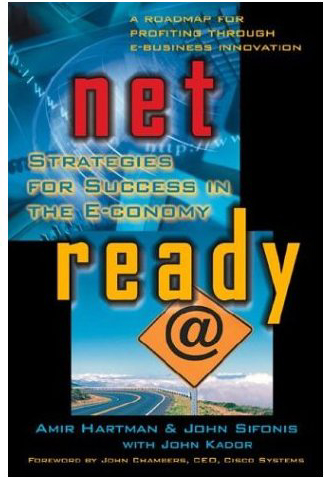
It been almost a decade since Net Ready was published (January, 2000) and a lot has changed since then. Now deep into the second major recession since the book encouraged us to operate as much of our business as we can over the Internet, what can we still learn from it – what still applies and what has changed?
The Internet is the most cost effective communications system ever devised since the beginning of man. It uses less energy that smoke signals or jungle drums and provides more information per $ than: telegraph, telephone, telex, and TWX. It has more persistence and reusability than radio or TV (even with Tivo) and is compatible with a wide variety of media: landlines including copper and fiber optics, satellite, microwave and various radios. It is truly an epoch creating technology and one that every business needs to embrace enthusiastically to get and remain competitive.
Web 2.0 and SaaS
How can we cut costs and improve operations and customer satisfaction by becoming Net Ready 2.0? In 2000, the book preached moving as many business functions as possible to the Internet. This is still very good advice but the Internet of 2000 is very different from the Internet of 2009. The current Internet, Web 2.0, is built on the assumption that bandwidth is plentiful and cheap, and for the most part, it is. (The Internet of 2000 still had plenty of dialup access.) What does this mean for business? Well for one thing it means that SasS deployment can support more applications and those applications can have rich media interfaces. So, SaaS (hosted) solutions can cover more of your company needs. Additionally, with Web based applications being available to more casual users, the user interface can now be rich enough to help guide the user through complex applications without lengthy, productivity robbing delays.
SaaS deployment is enjoying rapid market growth, partly because of the deep economic downturn and partly because the technology and applications are getting better. IDC reports that growth is up 50% at the enterprise level and 30% for SMB.
To SaaS or not to SaaS
Let’s look at how hosted applications have grown to either meet or not meet the promise of 2000. A friend of mine, Chuck DeVita, has often said that the best way to deliver an application (hosted verses on-premise) is to deliver it the way the customer wants it. Implicit in Chuck’s statement (Chuck is a very experienced sales executive in Enterprise software) is that there is no one correct answer. It really depends on the needs of the organization. Hosted applications are easier to deploy, especially if you are starting from ground zero and do not have to deal with much legacy data. We are particularly fond of collaboration applications for the SaaS model. Yet, as we get more and more comfortable with Web based applications for collaboration we are sharing more and more sensitive data on the Web.
In particular, when it comes to Web conferencing, we need to pay attention to access security for meetings. The weakest security point in web conferencing is access security. Every web conferencing system today uses meeting IDs and/or passwords as simple access security measures to protect web meetings from unwanted attendance. However, the problem is that meeting IDs and passwords are usually emailed to attendees before scheduled meetings start. This process can easily compromise access security. Your computer screen may be captured within seconds once a hacker intercepts or guesses your meeting ID or password. Once you realize you have been hacked, it is too late to close your meeting.
As we deploy more and more applications on the Web, security will become more and more of an issue. What other issues do you think will become important as we make our businesses “Net Ready”?